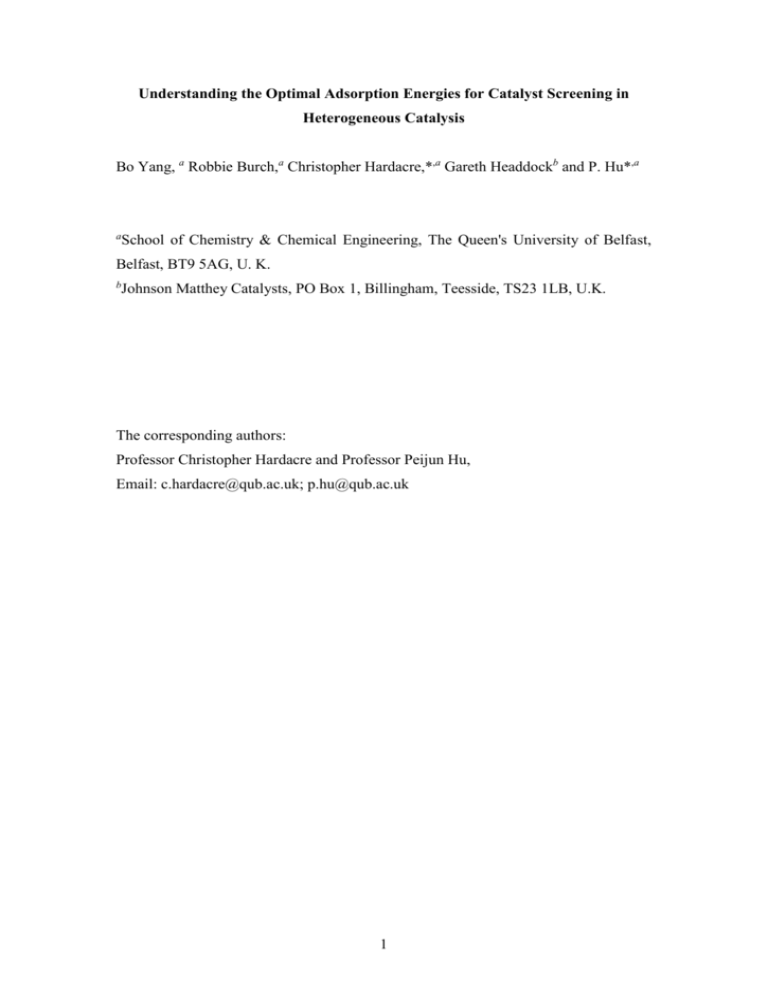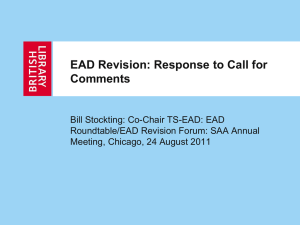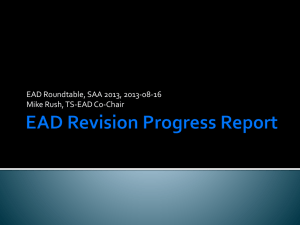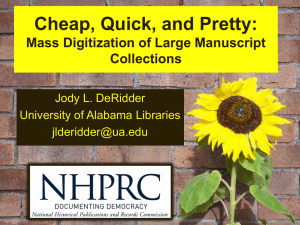Understanding the Optimal Adsorption Energies for Catalyst
advertisement

Understanding the Optimal Adsorption Energies for Catalyst Screening in Heterogeneous Catalysis Bo Yang, a Robbie Burch,a Christopher Hardacre,*,a Gareth Headdockb and P. Hu*,a a School of Chemistry & Chemical Engineering, The Queen's University of Belfast, Belfast, BT9 5AG, U. K. b Johnson Matthey Catalysts, PO Box 1, Billingham, Teesside, TS23 1LB, U.K. The corresponding authors: Professor Christopher Hardacre and Professor Peijun Hu, Email: c.hardacre@qub.ac.uk; p.hu@qub.ac.uk 1 ABSTRACT: The fundamental understanding of the activity in heterogeneous catalysis has long been the major subject in chemistry. This paper shows the development of a two-step model to understand this activity. Using the theory of chemical potential kinetics with Brønsted-Evans-Polanyi relations, the general adsorption energy window is determined from volcano curves, using which the best catalysts may be searched. Significant insights into the reasons for catalytic activity are obtained. KEYWORDS: heterogeneous catalysis; Brønsted-Evans-Polanyi relation; volcano curve; two-step model; adsorption energy window; catalyst design; chemical potential 2 1. Introduction Heterogeneous catalysis is of critical importance in energy conversion technologies, such as oil refining, fuel cells and solar cells, as well as in the fine chemical and pharmaceutical industries. A significant goal in this area is the use of theory to not only understand the adsorption, complex reaction and desorption processes, and thus provide explanations for experimentally observed phenomena, but also design new catalysts for experimental testing. Among the current methods employed to perform this type of catalyst prediction, the evaluation of the BrønstedEvans-Polanyi (BEP) relation and the volcano curve is the most frequently used. Regarding the BEP relation, it was proposed that there should be a linear correlation between the reaction barrier and the enthalpy change of the elementary reaction steps.1,2 Previous research, including ours, has reported some general linear relations between activation energies and enthalpy changes for dissociative and associative reactions calculated from density functional theory (DFT), in line with the classical BEP relations. Furthermore, an extended BEP relation was established between the transition state energy and the initial (final) state energy for the associative (dissociative) reactions, with the energies referenced to the gas phase reactant(s).3-15 Therefore, the BEP relation provides the possibility of estimating the reaction barriers (transition state energies) from the corresponding enthalpy changes (initial/final state energies).This is important since the calculation of the enthalpy changes (initial/final state energies) of the elementary steps is much more efficient than determining the reaction barriers. The volcano curve provides a relationship between the catalytic activities and the adsorption energies of a given reactant on the catalyst surface. The volcano curve is typically explained by the Sabatier principle, which states that the adsorption of the reactants on the catalyst surface should be neither too strong nor too weak to achieve high activity.16 This has also been exemplified using experimentally determined catalytic activity plotted as a function of the adsorption energy of specific species calculated from DFT where volcano type of curves were obtained.17-19 A recent study from our group proposed to understand volcano curves from the perspective of surface free sites, and a new insight was obtained.20 Moreover, volcano type of curves can be obtained by utilising the BEP linear relations without barrier calculations. Furthermore, it was demonstrated that the multiphase catalysts can be understood using a three dimensional volcano plot.21 3 Typically, new catalysts are developed by trial-and-error approaches experimentally, while DFT calculations have been shown to be possible for catalyst design/screening by computing adsorption energies and/or reaction barriers for catalytic processes.22 However, the theoretical catalyst design/screening processes may be further accelerated with more detailed analyses on the BEP relation and the volcano curve as well as the models developed over the past decade. For example, a kinetics theory based on chemical potential was developed in our group recently for heterogeneous catalysis which shows significant potential for catalyst design for dyesensitized solar cells.23-25 In this approach, the total energy profile was converted to the profile of chemical potential, and an explanation of the universality of the adsorption energy window in heterogeneous catalysis was proposed.6,8 In the current work, we analyse in detail the volcano curves derived from the two-step model,9,23,26 aiming to obtain a new understanding of the chemical potential kinetics as well as the adsorption energy window for optimal catalysts. It should be noted that a similar approach to the two-step model used in the current work was recently employed to understand electrocatalytic reaction processes by Koper.27 In this case, the potentialdetermining step should be considered for an electrocatalytic process. 2. Results and Discussion Taking the two-step model reported in our recent work as a starting point to describe heterogeneously catalysed reactions, namely the adsorption of reactants to form the intermediates and the desorption of the intermediate to the products9,23,26 (the energy profile of the two steps is shown in Figure 1), the following equations can be obtained: H EP ER ( EI ER ) ( EI EP ) Ead , R Ead , P (1) ERass ERdis Ead , R (2) EPass EPdis Ead , P (3) where ΔH is the enthalpy change of the overall reaction. Ead,R and Ead,P are the adsorption energies of the reactants and the products, respectively. ERdis and ERass are the barriers for the adsorption and the corresponding reverse reaction, respectively. Similarly, EPdis and EPass are the barriers for desorption and the reverse reaction, respectively. 4 Energy Adsorption ERdiss Desorption ER Ead,R ERass ΔH EI EPass Ead,P EPdiss EP Reaction Coordinate Figure 1. Schematic profile of the two-step model taking into consideration the dissociative adsorption of reactants and associative desorption of products on a heterogeneous catalyst surface. ΔH is the enthalpy change of the overall reaction. ER and EP are total energies of the gaseous reactants and products, respectively. Ead,R and Ead,P are the adsorption energies of the reactants and the products, respectively. ERdis and ERass are the barriers for the adsorption and the corresponding reverse reaction of the reactants, respectively. Similarly, EPdis and EPass are the barrier of desorption and the corresponding reverse reaction of the products, respectively. EI is the energy of the intermediate state. Using the BEP relation, we can write ERdis aR Ead , R bR (4) EPdis aP Ead , P bP (5) where aR, aP, bR and bP are constants. One can obtain the reaction rate of the overall reaction as:9,28 r kBT 1 ass S R ERdis 0 h P R RT PP RTG ERTR e e e e PR PR r k BT 1 ass E S EPass h P 0 R ad ,R EP R RT e e e RT PR if adsorption is the rate-determining step (6) if desorption is the rate-determining step (7) 5 where kB and h are constants, and T is the reaction temperature. P0, PR and PP are the standard pressure, partial pressure of the reactants and partial pressure of the products, respectively. ΔG is the free energy change of the overall reaction.SR is the entropy of the reactants. The details for the derivation of equations (6) and (7) can be obtained from the reference9 and Supporting Information (SI). Since ERdis , ERass , EPdis and EPass are all related to the adsorption energies of the reactants (Ead,R) or the products (Ead,P) via the BEP relations (equations (2)-(5)), and both adsorption energies are further related to the enthalpy change of the reaction (equation (1)), we can establish that the reaction rates will only be determined by the Ead,R for a given set of reaction conditions. Therefore, correlating the reaction rates with the adsorption energies of the reactants (Ead,R) gives rise to the volcano curves shown in Figure 2. We can see the following striking features: (i) There are three volcano curves, namely the curves obtained from the adsorption being the ratedetermining step (red), the desorption being the rate-determining (blue) and the overall one achieved from combining both the adsorption and desorption processes (black), respectively. (ii) In regions 1 and 2, the rates from the adsorption being ratedetermining are over-estimated (they are above the overall rates), while the rates from the adsorption one are almost the same as the overall one (they are overlap each other after Ead,R,max3) in regions 3 and 4. The opposite is true for the desorption one. (iii) There is only one maximum in the reaction rates associated with the adsorption being the rate-determining step and this is also true if the desorption is the rate-determining step. Correspondingly, Ead,R,max1, Ead,R,max2 and Ead,R,max3 are the adsorption energies of the reactants when the adsorption rate reaches maximum, the desorption rate reaches maximum or where the overall rate reaches the maximum, respectively. 6 Adsorption determining Desorption determining Full volcano curve Energy TSad TSde ER Region 4 Ead,R,max2 μR Region 3 Ead,R,max3 EP μP Region 2 Ead,R,max1 Ead,R (μIo) Region 1 Activity Reaction Coordinate Figure 2. Schematic diagram of the volcano curves associated with reactions where the adsorption (red) and desorption (blue) are rate determining together with the real volcano curve (black) (left). The right side of the figure shows the energy profiles on three typical catalysts. μR and μP are the chemical potentials of the gaseous reactants and products, respectively. Interestingly, the values of Ead,R,max1 and Ead,R,max2 can be determined analytically by solving the following partial differentiatials: P G R P0 R R [ e R e RT P e RT e RT ] PR PR 0 ( Ead , R )T , PR , PP S S E dis E E ass E ass (8) E ass P P 0 R ad ,R P [ e R e RT e RT ] PR 0 ( Ead , R )T , PR , PP (9) Combining equations (1)-(5), (8) and (9), equations (10) and (11) are obtained: 1 aR P Ead , R ,max1 RT ln( ) RT ln( P0 ) TS R G aR P (10) 1 aP P Ead , R ,max 2 RT ln( ) RT ln( R0 ) TS R aP P (11) In addition, Ead,R,max3 is the cross point between the adsorption-determining and desorption-determining curves, and thus can also be obtained by combining the equations (6) and (7): 7 Ead , R ,max 3 RT ln( PR ) bP bR TS R (1 aP )H P0 1 aR aP (12) Compared with Ead,R,max1 and Ead,R,max2, which consist of aR and aP, respectively, Ead,R,max3 contains more variables, such as bR and bP. Since aR and aP are well known to be around 0-1 for most reactions while bR and bP need to be determined from a set of catalysts, Ead,R,max1 and Ead,R,max2 may be easier to be used. After careful examination of the curves in Figure 2, we can achieve the following trends: (i) When the reactants interact with the catalyst surface very strongly, shown as region 1 in Figure 2 (i.e. where Ead,R<Ead,R,max1), it will result in energy profiles in the lower area on the right hand side of Figure 2 such as the blue energy profile, and the free site coverage should be low at the steady state, leading to a low reaction rate due to reactant poisoning. (ii) When the interaction between the reactants and the catalyst surface is too weak, indicated as region 4 (i.e. where Ead,R>Ead,R,max2), the reaction is governed by energy profiles in the upper area on the right hand side of Figure 2 such as the red energy profile, and low steady state coverage of reactants on the surface will be formed, also leading to a low rate of reaction. (iii) When the adsorption energy of the reactants shifts to regions 2 and 3 in Figure 2 (i.e. where Ead,R,max1<Ead,R<Ead,R,max2), the surface has the ideal coverage of the adsorbed species and free sites so that both the adsorption of reactants on the surface and the desorption of products from the surface are facile. Having obtained the two critical adsorption energies, Ead,R,max1 and Ead,R,max2, we are in a position to quantitatively address the adsorption energy window: Nørskov and co-workers discovered that there is a universal adsorption energy window within which the excellent catalysts can be found for several reactions.6,8 Since this is such an important result, it is worth discussing whether our framework in the current work can provide any insight into this issue. From the above detailed analyses, we can suggest that the optimal catalysts for a given reaction condition should have reactant adsorption energies within the energy rang between Ead,R,max1 and Ead,R,max2 as denoted by equations (10) and (11). By applying the chemical potentials of gaseous species (see equation S3 in the SI) to equations (10) and (11), we can readily obtain: 8 1 aR Ead , R ,max1 RT ln( ) P H R aR (13) 1 aP Ead , R ,max 2 RT ln( ) R H R aP (14) where μR and μP are the chemical potentials of the reactants and products, respectively. Since the energy of the gaseous reactants is usually taken to be zero as a reference point in potential energy profiles, HR can be eliminated from equations (13) and (14). Using the fact that Ead,R,max1<Ead,R<Ead,R,max2, as discussed above, we can write the following equation for optimal catalysts: 1 aP 1 aR ) Ead , R P RT ln( ) aP aR R RT ln( (15) It is clear from equation (15) that the optimal adsorption energy of the reactant is determined by R , P , aR , and aP . It is known that aR is close to 1 with a typical range of 0.8-1,4,6,7,9,23and our previous work showed that aP is around 0.3.9 Taking aR , 1 aR ) and and aP as 0.9 and 0.3, respectively, as an example, the terms RT ln( aR 1 aP RT ln( ) are -0.09 and 0.04 eV at 500 K, respectively, it follows that: aP R 0.04 Ead , R P 0.09 (16) This means that the optimal adsorption energy window is from R 0.04 to P 0.09 . Interestingly, using the theory of chemical potential kinetics and the surface free sites a recent study from our group23 derived an adsorption energy window to be R Ead , R P , where is about 0.1~0.2 eV for 500 K, which is very close to the current work. It is worth noting that the energy window in the current work is analytically derived from the maxima of volcano curves obtained from the two-step model coupled with BEP relation without any other assumptions. If one goes one step further, a simple adsorption window of R Ead , R P can be obtained, omitting the small energies of 0.04 and -0.09 eV. It is clear from the discussion above that Ead,R,max1 and Ead,R,max2 from equations (10) and (11) are of great importance to the activity of catalysts for a given reaction. Hence, it is worth discussing the physical meanings of these two terms. We can see from equations (10) and (11) that the parameters expressing Ead,R,max1 and Ead,R,max2 9 fall into three groups: (i) the reaction conditions, such as PR, PP and temperature; (ii) the thermodynamic parameters, including ΔG and SR; and (iii) the kinetic parameters, e.g. aR and aP. However, the contribution from kinetic parameters to Ead,R,max1 and 1 aR 1 aP ) and RT ln( ) being only -0.09 and 0.04 eV, Ead,R,max2 is very small, RT ln( aR aP respectively, as discussed above. The kinetic contribution to Ead,R,max1 and Ead,R,max2 is so small that it can be omitted, and thus they will only be determined by the reaction conditions and the thermodynamic parameters. This is a very surprising result, considering that Ead,R,max1 and Ead,R,max2 are derived from reaction kinetics. It should be noted that there are some limitations in the model described. Firstly, our model can only be applied to the systems having the same mechanism for each of the catalysts screened. Secondly, it is assumed that there is only one rate-determining step in the system, whereas in real systems there may be more than one rate-limiting step. Therefore, our model is a simplified description of real systems and it may only be valid for some of real systems. Despite the limitations it does provide an approach to rapidly screen catalysts for a given reaction. Future comparisons with experimental data will provide some guidance as to the accuracy of the predictions from the model. 3. Conclusions In summary, a two-step model has been used to gain insight into the kinetics of heterogeneous catalytic reactions. Optimal adsorption energies of reactants for (i) the overall reaction (Ead,R,max3); (ii) assuming that the adsorption is the rate determining step (Ead,R,max1); and (iii) assuming that the desorption process is the rate determining step (Ead,R,max2) are analytically obtained. The best catalysts are suggested to locate between Ead,R,max1 and Ead,R,max2 and the energy window to search for optimal catalysts is derived to be R 0.04 Ead , R P 0.09 or simply m R > Ead ,R > m P . Insights into the activity of heterogeneous catalytic reactions are obtained. Acknowledgements This work is financially supported by EPSRC and Johnson Matthey through the CASTech programme (EP/G012156/1). We acknowledge helpful discussions with Dr. Jun Cheng (University of Cambridge/University of Aberdeen) and B.Y. thanks the 10 financial support of the Dorothy Hodgkin Postgraduate Award (DHPA) studentship jointly funded by EPSRC and Johnson Matthey. Supporting Information Available The supporting information presents the derivation of the reaction rates of the adsorption and desorption determining processes and the derivation of the relation between the adsorption energy window and the chemical potential window. References (1) (2) (3) (4) (5) (6) (7) (8) (9) (10) (11) (12) (13) (14) (15) (16) (17) (18) (19) (20) (21) (22) (23) (24) Brønsted, J. N. Chem. Rev. 1928, 5, 231. Evans, M. G.; Polanyi, M. Trans. Faraday Soc. 1938, 34, 11. Pallassana, V.; Neurock, M. J. Catal. 2000, 191, 301. Logadottir, A.; Rod, T. H.; Nørskov, J. K.; Hammer, B.; Dahl, S.; Jacobsen, C. J. H. J. Catal. 2001, 197, 229. Liu, Z. P.; Hu, P. J. Chem. Phys. 2001, 115, 4977. Nørskov, J. K.; Bligaard, T.; Logadottir, A.; Bahn, S.; Hansen, L. B.; Bollinger, M.; Bengaard, H.; Hammer, B.; Sljivancanin, Z.; Mavrikakis, M.; Xu, Y.; Dahl, S.; Jacobsen, C. J. H. J. Catal. 2002, 209, 275. Michaelides, A.; Liu, Z. P.; Zhang, C. J.; Alavi, A.; King, D. A.; Hu, P. J. Am. Chem. Soc. 2003, 125, 3704. Bligaard, T.; Nørskov, J. K.; Dahl, S.; Matthiesen, J.; Christensen, C. H.; Sehested, J. J. Catal. 2004, 224, 206. Cheng, J.; Hu, P.; Ellis, P.; French, S.; Kelly, G.; Lok, C. M. J. Phys. Chem. C 2008, 112, 1308. Nørskov, J. K.; Bligaard, T.; Hvolbæk, B.; Abild-Pedersen, F.; Chorkendorff, I.; Christensen, C. H. Chem. Soc. Rev. 2008, 37, 2163. Loffreda, D.; Delbecq, F.; Vigné, F.; Sautet, P. Angew. Chem.-Int. Edit .2009, 48, 8978. van Santen, R. A.; Neurock, M.; Shetty, S. G. Chem. Rev. 2010, 110, 2005. Gong, X. Q.; Liu, Z. P.; Raval, R.; Hu, P. J. Am. Chem. Soc. 2004, 126, 8. Yang, B.; Burch, R.; Hardacre, C.; Headdock, G.; Hu, P. ACS Catal. 2012, 2, 1027. Yang, B.; Gong, X.-Q.; Wang, H.-F.; Cao, X.-M.; Rooney, J. J.; Hu, P. J. Am. Chem. Soc. 2013, 135, 15244. Sabatier, P. Ber. Dtsch. Chem. Ges. 1911, 44, 1984. Toulhoat, H.; Raybaud, P. J. Catal. 2003, 216, 63. Guernalec, N.; Geantet, C.; Cseri, T.; Vrinat, M.; Toulhoat, H.; Raybaud, P. Dalton Trans. 2010, 39, 8420. Over, H.; Schomäcker, R. ACS Catal. 2013, 3, 1034. Wang, H.; Guo, Y.; Lu, G.; Hu, P. J. Chem. Phys. 2009, 130, 224701. Cheng, J.; Hu, P. J. Am. Chem. Soc .2008, 130, 10868. Studt, F.; Abild-Pedersen, F.; Bligaard, T.; Sørensen, R. Z.; Christensen, C. H.; Nørskov, J. K. Science 2008, 320, 1320. Cheng, J.; Hu, P. Angew. Chem.-Int. Ed. 2011, 50, 7650. Hou, Y.; Wang, D.; Yang, X. H.; Fang, W. Q.; Zhang, B.; Wang, H. F.; Lu, G. Z.; Hu, P.; Zhao, H. J.; Yang, H. G. Nature Comm. 2013, 4, 8. 11 (25) (26) (27) (28) Zhang, B.; Wang, D.; Hou, Y.; Yang, S.; Yang, X. H.; Zhong, J. H.; Liu, J.; Wang, H. F.; Hu, P.; Zhao, H. J.; Yang, H. G. Sci. Rep. 2013, 3, 7. Yang, B.; Burch, R.; Hardacre, C.; Headdock, G.; Hu, P. J. Catal. 2013, 305, 264. Koper, M. T. M. J. Solid State Electrochem.2013, 17, 339. Dumesic, J. A. J. Catal. 1999, 185, 496. 12 Adsorption energy of the reactant TOC Low activity μR High activity, Ideal catalysts μP Low activity 13







